Twitter has been here for quite a while, but it has really grown in the recent two years. And lately, with the people tweet to share their ideas and opinions as well as notify their friends (aka followers) about the current news, almost every business is using Twitter constantly for promotion offers and other valuable information.
The competition in the online world is pretty severe, and Twitter is no exception. The users need to become more and more creative to make you follow them. Another important task is preserving the follower’s base. And one the ways to achieve that is to let them share an opinion with the “big brother” – the brand. That’s what Twitter Chat is about – allow followers (aka customers) to ask questions and offer personal opinions. Although it is doubtful that any of these ideas will be actually heard in the company HQ (although some certainly might), the “round-table” definitely present a certain level of satisfaction for the clients.
Additionally, this emphasizes a very important thing in the internet era – there are actual people behind the brand. @username is not a tweeting robot; it is a living human being that can chat with you from time to time.
The marketing has always been about customer’s psychology – learning the specific needs of a potential client and trying to satisfy them. Google has demonstrated once again that targeting certain audience is mandatory. And if you are into SEO, you should be aware of it.
According to one recently published study, Google Search results on a smartphone will vary by over 80% from those produced by a desktop computer query. If you think about it – this is actually quite logical to have a slightly different search algorithm for smartphones. For example, smartphone users like downloading various applications. Thus the mobile Google Search presents many results that include the word “app” or “download”. Brand filters and store filters cannot be applied to mobile Google search and it is even more biased towards “local” domains, with Google places usually appearing higher in the vertical results list.
With the smartphone market growing quickly, it seems as only a matter of time when “SEO for mobile” will become a separate branch in the industry.
According to several anonymous sources, Googel is planning to launch an e-newsstand application that will run on Android tablets and smartphones in order to battle Apple’s iTunes sales.
Leading publishers, such as Time Inc and Wall Street Journal, are being approached by the not-only-biggest-Search-Engine executives in order to establish a fruitful cooperation and figure out the most beneficial way of application development. Commissions lower than those of Apple’s (30 percent) are being promised as well as various advanced buyer’s data-gathering features.
When all this is going to happen is unclear, and some doubt that the venture will launch at all – but the initiative is too important to overlook as Google looks to enter another niche.
It’s no big news that Chinese market is growing with an impressive speed and more and more businesses turn eastwards – both for production and marketing. Over a billion people live inside the Far East giant borders – a healthy reason to address the region in order to increase sales as well as exposure.
The news is, however, that the internet content is now also part of the trend. China has reportedly surpassed USA in the number of internet users in mid-2009, and although English is still the primary internet language (42 percent of almost two billion of online “population” worldwide), Chinese is in solid second place, with about 32 percent. And since China is still less technologically advanced than the Western Countries, the number of potential Chinese speakers, who will soon be joining the online world is far greater than that of the English language carriers.
And with the Chinese government now requiring all English content in China-based websites to be accompanied with local Mandarin translation, the number of webpages in Chinese is about to increase immensely. And, restating the above thought about more and more companies regarding China as a prospective market, it seems that the near future of online marketing can easily shift toward Chinese content.
UK shopping market maybe smaller than the US one, but Google wants to make an impact on it as well, introducing Google Nearby Shops UK. Now, when you query for certain product via UK Google Product Search, you will have the shops selling it appearing map-style below your search, to help you locate the closest item to your location.
Of course, if you are a merchant and want to take advantage of this feature, becoming listed in those results, you need to have your shop’s URL linked to both Google Places and Google Merchant Center.
For both buyers and sellers, this combination of Google Maps and Google Products can be very useful in this Holiday season.
After Google had announced its intention to acquire the renowned flight data provider ITA (the offer stands, reportedly, at 700 million USD), several serious questions arouse. Wouldn’t it be too much a step towards monopoly? What are the benefits for the customers? Why, the hell, Google is buying ITA at all?
Well, the answer to the last question is pretty obvious. In recent years, Google seems to enter every niche available in the market. Long gone are the times when Google was just a search engine. Google maps, Google news, Google Sketch-up – more and more services are provided by the enterprise and some people are already asking – is Google a Search Engine or your ultimate competitor?
However, the Google ITA offer has now encountered a serious opposition itself. A group of businesses, namely the Fairsearch.org, have gathered together in order to prevent the deal. With ITA serving about two thirds of airline ticketing and satellite websites, the ultimate “danger” – according to the Fairsearch claim – is that Google will eventually start selling tickets directly, while it has a control of data flow towards potential competitors.
Google, of course, claims that the intention is purely to improve the service, making flight data offered by Google more reliable and continuing to redirect the searchers to other websites that offer flight tickets.
With the consequences of this case remain to be seen , one thing is clear – more and more businesses (including the giants like Microsoft and Expedia) are concerned with Google taking over.
Google has recently announced that Google Instant Mobile is now available “globally”. This means that the tool is released for all countries that have Google Mobile access (there are several dozens of those) and supports almost thirty languages.
The product, similarly to Google Instant Mobile, is integrated into search features for any Android browser (built-in for Android OS 2.2 and up) , and features various algorithms that allow faster dynamic search results.
Although this release was expected (shortly after releasing Google Instant Mobile in English, the company had announced that international support is on its way) – nobody anticipated that this would happen so quickly. The roll-out took Google slightly over one month time – an incredible figure, considering the complexity of the product. Of course, this simply means that Google had been working on globalization of Google Instant Mobile simultaneously with the product itself. That is no wonder – Google had always emphasized the importance of international marketing and global support.
Telemarketing was never a part of Google business strategy. The idea was to spread the information, get recognizable and make the clients come to them, asking for services. That’s were the sales managers stepped in, offering a variety of products, bargain deals and impressing the customer.
However, according to latest news, this has recently changed. Several hundreds of telemarketers are employed by the company, their task being to sell Google Boost and Google Tags services to local businesses at several markets in the US.
It seems the Rubicon has been crossed and Google has now “recognized” that some niches and companies should be addressed directly rather than by advertising. The next question, which should be probably answered in few months time, is whether they will expand their own telemarketing group (reportedly currently measuring 300 employees) or try to purchase an established sales force.
After all, with Groupon denying “the 6 billion offer”, Google has some money to spare…
Greetings LilEngine readers and users. We would like to take this opportunity to let you know, as if you haven’t noticed, that we have merged two of our internet marketing properties into one. After careful consideration we decided that the management of two separate websites and blogs was simply getting to be too much. We need to narrow our efforts to consolidate everything to one strong internet marketing resource.
We feel that this will permit us to bring more quality content, information and new tools to you in one concise and clear website. We are trying to make this move as easy as possible and we welcome your feedback. If you find a broken link or missing post, please let us know by contacting us at info@seomoves.org. Needless to say, maintaining all of the website structure and content on LilEngine and moving it was a massive project; we have completed about 85% as of now. Over the coming week we should be able to have 99% of the move completed.
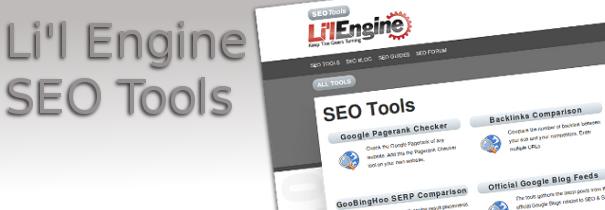
If you haven’t checked out our tools page, you should. We’ve got all kinds of things to make it easier to evaluate and improve your own website and find out how your competitors stack up.
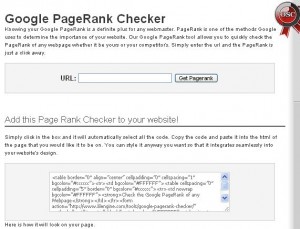 The Google PageRank Checker (see screen shot) does exactly what it says. You type in a URL and it tells you the site’s Google Toolbar PageRank. This is a “snapshot” of Google’s mysterious, patented PageRank formula that conveys the authoritativeness of a given page. There’s not actually a publicly accessible tool for finding the patented Google PageRank, but Google Toolbar PageRank will help you determine how authoritative a page is when used with other factors like a page’s back links, anchor text, and number of links. Keep in mind that a high PageRank doesn’t necessarily mean a site will rank high in the search results. PageRank is great, but search engine optimization is the key to ranking high in most cases.
The Google PageRank Checker (see screen shot) does exactly what it says. You type in a URL and it tells you the site’s Google Toolbar PageRank. This is a “snapshot” of Google’s mysterious, patented PageRank formula that conveys the authoritativeness of a given page. There’s not actually a publicly accessible tool for finding the patented Google PageRank, but Google Toolbar PageRank will help you determine how authoritative a page is when used with other factors like a page’s back links, anchor text, and number of links. Keep in mind that a high PageRank doesn’t necessarily mean a site will rank high in the search results. PageRank is great, but search engine optimization is the key to ranking high in most cases.
Back links are links that point to a site from other sites. They are a prime source of PageRank juice (though not the only source). Having a lot of high quality back links that are obtained honestly will seriously help your site’s Google rankings as well as PageRank. The Backlinks Comparison Tool lets you compare the number of back links to a list of websites. It couldn’t be easier: enter a URL on each line, then hit “Get Backlinks Count.”
The Google+Bing SERP Preview can show you how a web page will appear in the Google and Bing search results. This will help you improve your title and meta description tags. The screen shot shows a test case for lilengine.com with the fields filled in. You click “Preview” to get your results (seen in the next screen shot). Once you have your results, you can click on the “Compare” button. A new window will come up showing you how the results actually look in either Google or Bing results.

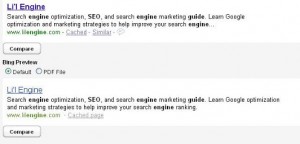
Our Official Google Blog Feeds is a site you should bookmark if you haven’t already. In one place it gives you live feeds from the following Google blogs:
The Link Report Tool analyzes the links on a given web page and generates a report. You type in a URL and click on “Generate Report.” You have the option of filtering links in a number of ways. For example, you can have it check all the links, broken links, internal, outbound, or redirected links, nofollow links (the kinds that search engines won’t follow), or unknown links, which for whatever reason can’t be analyzed. If you click on the link in the report, you’ll get a brief summary of the link, including the URL, the anchor text, the http response, and problems encountered. You can also view the link HTML from the web page. You can see in the screen shot the initial results of a report on a page from Techdirt.com.
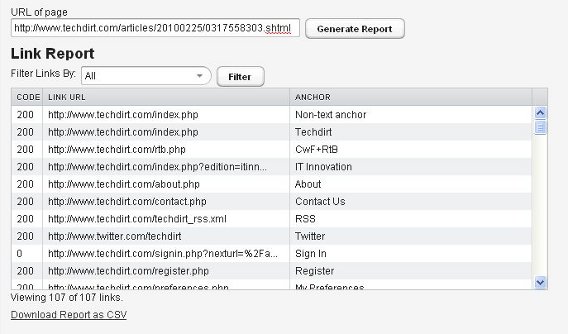
You can use the Google Penalty Checker to test for possible penalties from Google. You enter a domain name in the box and click “Check” to get a quick check of whether a site has been penalized. If you see warnings related to keywords on your site, you might want to investigate these. They may not mean a penalty has been issued, they do indicate that your SEO could be improved. If a site is not penalized, your result will be a happy green check mark indicating Google seems to think it’s A-OK. If a site has been penalized, you’ll see a big red “X” instead.
If you want to know the keywords a domain is ranking for in Google search results, you can use the Keyword Position Checker. You simply type in a domain name and choose which version of Google to check against (Google.com, Google.ru, Google.de, or Google.fr). The results include keywords, position, result count, and URL of the page in the results.
Our Keyword Competitors tool shows you the competitors that rank for the same keywords as your domain. Type in your domain name. You’ll get a report showing you your competitors. In the results, if you click on a competitor you’ll get a side-by-side comparison of keywords both of you rank for, and what position your site ranks for a given keyword.
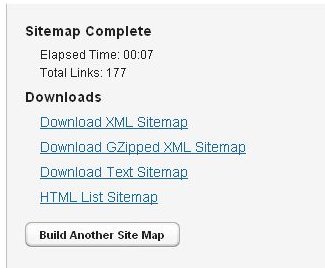 Hey, wanna get a sitemap for your new website? Use our Sitemap Builder. It’s easy. The tool crawls your website and makes a Google Sitemap. If you don’t have a sitemap, you should. It helps search engine crawlers like Googlebot find the pages on your site, determine their relative importance, and tell which pages have recently changed. You type in your domain, and in a matter of seconds the tool will generate a sitemap, as you can see in the screen shot. You can easily download your sitemap in several different forms.
Hey, wanna get a sitemap for your new website? Use our Sitemap Builder. It’s easy. The tool crawls your website and makes a Google Sitemap. If you don’t have a sitemap, you should. It helps search engine crawlers like Googlebot find the pages on your site, determine their relative importance, and tell which pages have recently changed. You type in your domain, and in a matter of seconds the tool will generate a sitemap, as you can see in the screen shot. You can easily download your sitemap in several different forms.
These aren’t all the tools in our toolbox, and we’re always updating and adding tools, so check out the tools page often and use these tools to help your site make it to the top of the search results.